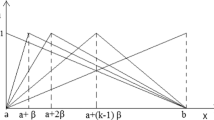Abstract
Development of computer-based medical inference systems is always confronted with some difficulties. In this paper, difficulties of designing an inference system for the diagnosis of arthritic diseases are described, including variations of disease manifestations under various situations and conditions. Furthermore, the need for a huge knowledge base would result in low efficiency of the inference system. We proposed a hierarchical model of the fuzzy inference system as a possible solution. With such a model, the diagnostic process is divided into two levels. The first level of the diagnosis reduces the scope of diagnosis to be processed by the second level. This will reduce the amount of input and mapping for the whole diagnostic process. Fuzzy relational theory is the core of this system and it is used in both levels to improve the accuracy.
Similar content being viewed by others
References
Bellamy, J.E.C.Medical diagnosis, diagnosis spaces, and fuzzy systems. Journal Of The American Veterinary Medical Association. (210): 390–396, 1997.
Resnick, D. and Niwayama, G.Ankylosing Spondylitis. Diagnosis of Bone And Joints Disorder, 3 ed. Philadelphia: W B Saunders. 1008–1074, 1995.
Resnick, D. and Niwayama, G.Psoriatic Arthritis. Diagnosis of Bone And Joints Disorder, 3 ed. Philadelphia: W B Saunders. 1075–1102, 1995.
Resnick, D. and Niwayama. G.Rheumatoid Arthritis. Diagnosis of Bone And Joints Disorder, 3 ed. Philadelphia: W B Saunders. 866–970, 1995.
Bellamy, J.E.C.Fuzzy systems approach to diagnosis in the postpartum cow. Journal of the American Veterinary Medical Association. 210: 397–401, 1997.
Resnick, D.Rheumatic fever. Diagnosis of Bone And Joints Disorder, 3 ed. Philadelphia: W B Saunders. 1252–1260, 1995.
Resnick, D.Target area approach to articular disorders: a synopsis. Diagnosis of Bone and Joints Disorder, 3 ed. Philadelphia: W B Saunders. 1757–1780, 1995.
DeBaets, B. and Kerre, E.Fuzzy relation composition. Fuzzy Sets and Fuzzy Systems. 60: 109–120 1993.
Leitich, H., Adlassing, K. P., and Kolarz, G.Development and evaluation of fuzzy criteria for the diagnosis of rheumatoid arthritis. Methods of Information In Medicine. 35: 334–342, 1996.
Bandler, W., and Kohout L.J.Semantics of implication operators and fuzzy relational products. International Journal of Man-Machine Studies. 12: 89–116, 1980.
Yew, K.M.Interval-valued approximate inference using fuzzy relational techniques. Ph.D. Dissertation. The Florida State University. 1995.
Nasreddine, H., and Yew, K.M.ADissertation of the K triangle inference templates shows how vulnerable they are. IEEE WCCI FUZZ-IEEE98 World Congress on Computational Intelligence. Alaska. May 4–9 1998.
Jain, R., Mazumdar, J., and Moran, W.Application of fuzzyclassifier system to coronary artery disease and breast cancer. Australasian Physical and Engineering Sciences In Medicine. 21: 141–147, 1998.
Pena-Reyes, C.A., and Sipper, M.A fuzzy-genetic approach to breast cancer diagnosis. Artif Intell Med. 17(2): 131–155, 1999.
Colombet, I., Jaulent, M.C., Diebold, B., and Degoulet, P.Implementation of a fuzzy prototype-based machine learning method to predict myocardial infarction from coronary angiography. Medinfo. 9 Pt 1: 498–502, 1998.
Belacel, N., Vincke, P., Scheiff, J.M., and Boulassel, M.R.Acute leukemia diagnosis aid using multicriteria fuzzy assignment methodology. Comput Methods Programs Biomed. 64(2): 145–151, 2001.
Fathi-Torbaghan, M., and Meyer, D.MEDUSA: a fuzzy expert system for medical diagnosis of acute abdominal pain. Methods Inf Med. 33(5): 522–529, 1994.
Shiomi, S., Kuroki, T., Jomura, H., Ueda, T., Ikeoka, N., Kobayashi, K., Ikeda, H. and Ochi, H.Diagnosis of chronic liver disease from liver scintiscans by fuzzy reasoning. J Nucl Med 36(4): 593–598, 1995.
Sztandera, L.M., Goodenday, L.S. nad Cios, K.J.A neurofuzzy algorithm for diagnosis of coronary artery stenosis. Comput Biol Med. 26(2): 97–111, 1996.
Author information
Authors and Affiliations
Corresponding author
Rights and permissions
About this article
Cite this article
Lim, C.K., Yew, K.M., Ng, K.H. et al. A proposed hierarchical fuzzy inference system for the diagnosis of arthritic diseases. Australas. Phys. Eng. Sci. Med. 25, 144–150 (2002). https://doi.org/10.1007/BF03178776
Received:
Accepted:
Issue Date:
DOI: https://doi.org/10.1007/BF03178776




